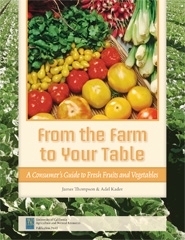Farmers markets and produce stands are starting to bulge with the bounty of California's fields as strawberries, artichokes and asparagus mark the start of the spring and summer produce seasons.
But have you ever wondered what to look for when selecting fruits and vegetables? Why does your refrigerator have separate bins for fruits and vegetables? Should fresh tomatoes be stored in the refrigerator or on the counter? And how do you keep fresh basil fresh until you're ready to use it?
These and many more questions are answered in the colorful handbook: From the Farm to Your Table: A Consumer's Guide to Fresh Fruits and Vegetables available at anrcatalog.ucdavis.edu

This guide contains tips from the pros on selection, storage and handling for quality and safety. Handy tables show you which fruits and vegetables should be stored in the refrigerator, which should be stored on the counter, and what to look for when selecting popular produce items. And if you've ever wondered the steps your produce takes to get from the field to your market, the journey is explained here.
After reading this guide you'll know why there's more to fruit and vegetable quality than meets the eye.
Oh, and the answers to those questions?
Your refrigerator has separate bins so you can keep keep ethylene-producing fruits such as apples, peaches and pears away from vegetables.
Uncut tomatoes should be stored on the counter, not in the refrigerator.
And keep your basil fresh by treating it like cut flowers; place the stems in a glass of water on the counter until you're ready to use it.